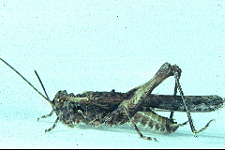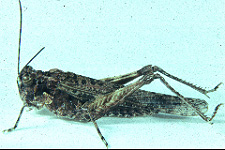Grasshoppers of Wyoming and the West
Entomology
Derotmema haydeni (Thomas)
 |
 |
| Adult male | Adult female |
Common name - Hayden's grasshopper (Helfer, 1972).
Geographic distribution - from Alberta and Saskatchewan (Canada) to New Mexico and east to the Dakotas, Nebraska and Kansas (Brooks, 1958). Its Colorado range generally is from the Great Plains to the eastern mountain valleys (Hebard, 1929), but it occasionally is recovered in western Colorado.
Habitat - sandy and gravelly soil along rivers and on margins of wet spots in sandy, alkaline areas. It is found largely on sagebrush, often simulating its color (Brooks, 1958; Bruner, 1897; Scudder, 1900).
Food habits - a mixed feeder, preferring grasses. It has been observed feeding on bahia, scarlet globemallow, sunsedge, fringed sage, threeawn, blue grama, sand dropseed and fourwing saltbush (Brooks, 1958; Kumar et al., 1976).
Eggs - females produce about 16 pale yellow eggs arranged in two columns within the pod. Average egg length, 4.3 mm; average diameter, 1.1 mm (Onsager and Mulkern, 1963). Nymph - five instars (Scoggan and Brusven, 1972).
Adult - small to medium size. General color is brownish. Face is almost vertical. Vertex
is rounded. Eyes are bulging. Antennae are slender. Pronotum has short ridges and
wrinkles, the dorsal posterior margin forms an obtuse angle. Lateral lobes of pronotum
are rounded. Median carina of pronotum has two distinct transverse incisions. Tegmina
are brownish with darker brown markings. Wings are yellow or red with a broad black
band and a clear apex. Male length, 22 mm; female, 25 mm (Ball et al., 1942; Hewitt
and Barr, 1967).
In flight D. haydeni makes a series of six to 10 short, sharp clicks in rapid succession (Scudder, 1900).
Seasonal history - overwinters in the egg stage. Adults can be found from late June to early July (Ball et al., 1942; Newton et al., 1954).
Abundance and importance - very common in most areas of Colorado (Caudell, 1903). It inhabits the poorer parts of the rangeland (Scoggan and Brusven, 1972).
D. haydeni fact sheet from the Field Guide to Common Western Grasshoppers
Next Species: Dissosteira carolina
Previous Species: Dactylotum bicolor
Biology of Common Colorado Grasshoppers List
Biology of Common Colorado Grasshoppers
Grasshoppers of Colorado Contents

